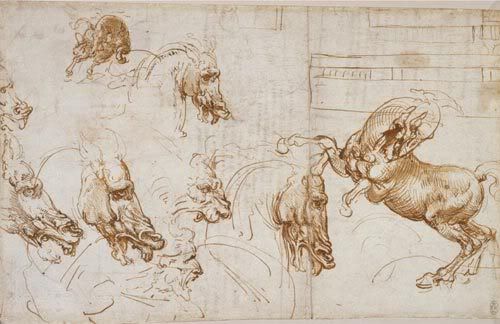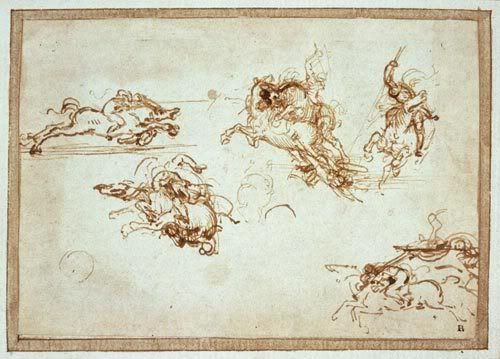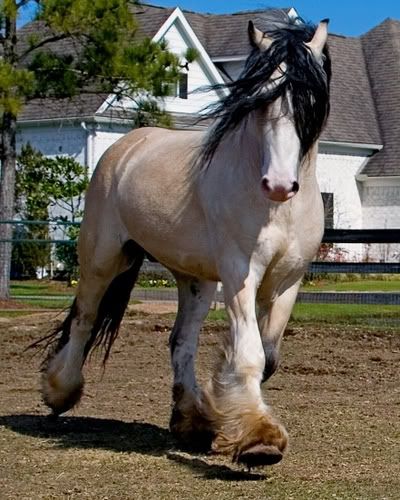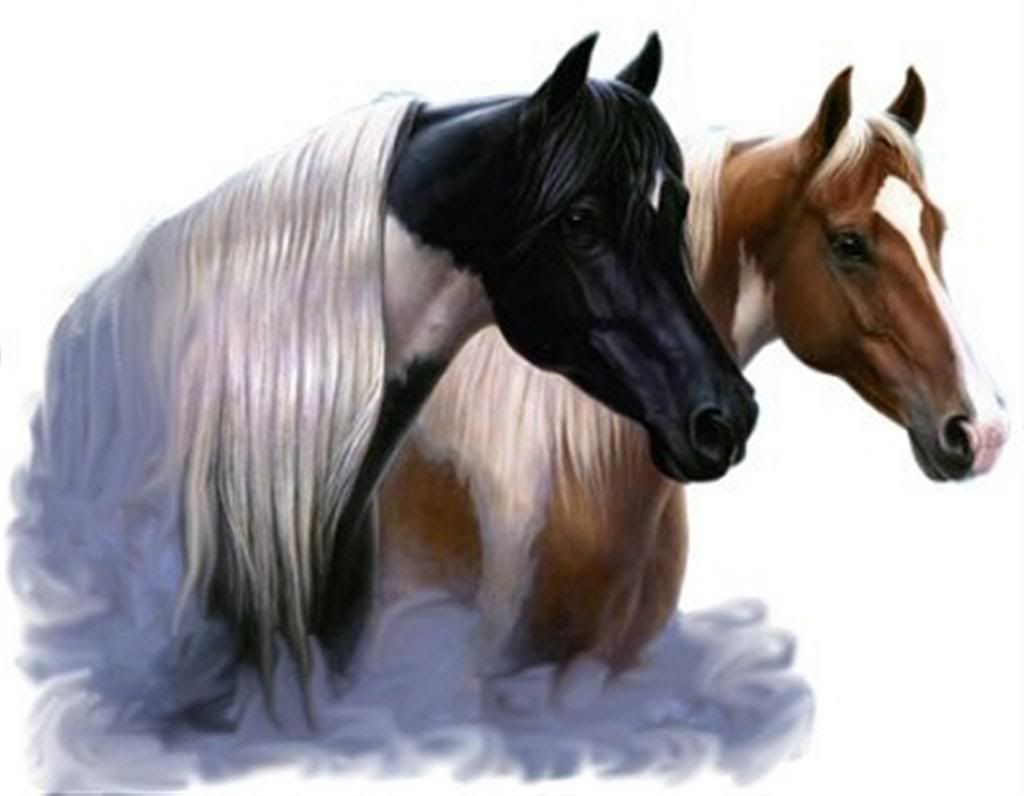We all know that Leonardo da Vinci was a famous scientist and artist, famous for paintings such as The Mona Lisa and The Last Supper along with his drawings of flying machnes and human anatomy, but he also drew a few horses in his time! Here are just a few.
Friday, April 16, 2010
Saturday, April 10, 2010
Gypsy Vanner Horses
Origin: Ireland, England and Wales.
Height Range: 12.2hh-17hh, average is about 14.2hh.
Colour: All colours accepted, but are mainly piebald or skewbald.
Temperament: Docile, intelligent, strong, gentle, with excellent stamina.
 The Gypsy Vanner Horse was bred by the gypsies primarily to pull their caravans known as 'vardo'. However, the horses were not recognised as an official breed until 1996. The gypsy vanner horses look like small shire horses with long, cascading manes, tails and feathers with short backs, strong shoulders and rounded withers.The breed contains blood from shires, clydesdales, friesians as well as dales and fell ponies. Most of these horses are found in Ireland and England, but they can now be found in other countries such as Australia, Canada, the U.S.A., Mexico, Germany, France and the Netherlands. They are not only used for driving in these countries, but are also used for dressage, pleasure riding, low jumping, children's mounts and even Western riding!
The Gypsy Vanner Horse was bred by the gypsies primarily to pull their caravans known as 'vardo'. However, the horses were not recognised as an official breed until 1996. The gypsy vanner horses look like small shire horses with long, cascading manes, tails and feathers with short backs, strong shoulders and rounded withers.The breed contains blood from shires, clydesdales, friesians as well as dales and fell ponies. Most of these horses are found in Ireland and England, but they can now be found in other countries such as Australia, Canada, the U.S.A., Mexico, Germany, France and the Netherlands. They are not only used for driving in these countries, but are also used for dressage, pleasure riding, low jumping, children's mounts and even Western riding! Bibliography
Crazy for Ponies by Karen Briggs and Shawn Hamilton, published by Scholastic, pg. 28
Pictures are from photobucket.
Sunday, March 7, 2010
Horse Quotes of Every So Often #1
"Horsemanship is not merely a matter of bodily skills, but is based on scholarship, and, therefore, is a matter of mind and intellect. Good horsemanship is based on proper character development and, therefore, is also a matter of mentality and spirit.Without the correct attitudes and insights, there cannot be the right sport." -Charles de Kunffy
"It is not enough for a man to know how to ride; he must know how to fall."-Mexican Proverb.
"It's a lot like nuts and bolts-If the rider's nuts, the horse bolts!"-Nicholas Evans
Wednesday, December 9, 2009
How To Drive A Horse.
Introduction.
Yay!! My first post!! Anyway, like many horse-crazy people, I have been taught how to ride a horse, not drive one. This often made me wonder how you would drive a horse from a carriage, especially since you only really have the reins and your voice to communicate with the horse/s being driven. So I thought that it would be interesting to find out, so here goes.
Assumptions I Have Made About You Driving A Horse.
1. The horse you are driving is trained for it and is relatively quiet.
2. You have managed to tack the horse up properly and have attached it to the carriage. I am sorry that I cannot write about how to do this as I myself have never done this before and would hate to give the wrong instructions for it due to my inexperience.
3. You have a driving teacher to help you.
4. You are driving one horse.
How to Drive A Horse.
How Do I Hold the Reins and the Whip?
The reins are held in the left hand, with the right rein held by the bottom two fingers and the left rein in the top two fingers, with the thumb on top. Sometimes the reins are quite long and some people sit on them or hold them under their feet so they don't get tangled up in anything. The driving whip is held upright in the right hand at a 45 degree angle. Both hands should be close together to help each other if needed. Never drop the reins or whip. Contact between your hands, the reins and the horse's mouth is the same when you are riding a horse. That is, you are not pulling or hanging onto the horse's mouth but can still feel it. The reins should not be too long and sloppy or too short and tight.
Going forwards.
When you want to walk, lighten the contact on the reins and say 'Walk on.'. If the horse is stubborn, you may need to tap (not hit) him/her with the whip. It is always better to get a horse to move off gently. Trotting is similar, but say 'Trot on.' and lighten your voice instead of saying 'Walk on.'.
Turning.
To turn right, roll your left hand forwards. To turn left, roll your left hand backwards.
Slowing Down and Stopping.
Halting is similar to how you halt while riding normally. To halt, say 'Haaaaalt.' or 'Whoooaaa.' and gently take up more contact with the reins. Stop doing this when the horse has stopped. You do roughly the same thing when asking the horse to slow down, but stop putting pressure on the horse's mouth and stop saying 'whoa' or 'halt' when the horse has slown down enough for you.
Rein Back
I didn't think that you could do rein back in a carriage, but in some types you can! To rein back, first halt the horse as discussed above. Then take up the contact evenly in both reins and say 'Back up.' or something similar. Release the contact as soon as the horse has done what you asked. To back to the left, follow instructions as above but take up more contact with the right rein and vice versa to back to the right.
Remember to stay as safe as possible while driving! You might also need to learn hand signals and rules for when driving on the road.
Bibliography and Recommended Reading/Viewing.
http://www.youtube.com/user/ManuelCat#p/a/u/2/u Lk9U6POLw-An informative video on how to drive a horse. Includes a bit more information than shown here.Also shows how to hold the reins if I've confused you.
http://www.ehow.com/how_2296993_drive-horse-drawn-carriage.html -An article I found useful.
Conclusion
I hope you found my article interesting! If I've got anything wrong or if I've left something out, please feel free to tell me so in the comments section!
Yay!! My first post!! Anyway, like many horse-crazy people, I have been taught how to ride a horse, not drive one. This often made me wonder how you would drive a horse from a carriage, especially since you only really have the reins and your voice to communicate with the horse/s being driven. So I thought that it would be interesting to find out, so here goes.
Assumptions I Have Made About You Driving A Horse.
1. The horse you are driving is trained for it and is relatively quiet.
2. You have managed to tack the horse up properly and have attached it to the carriage. I am sorry that I cannot write about how to do this as I myself have never done this before and would hate to give the wrong instructions for it due to my inexperience.
3. You have a driving teacher to help you.
4. You are driving one horse.
How to Drive A Horse.
How Do I Hold the Reins and the Whip?
The reins are held in the left hand, with the right rein held by the bottom two fingers and the left rein in the top two fingers, with the thumb on top. Sometimes the reins are quite long and some people sit on them or hold them under their feet so they don't get tangled up in anything. The driving whip is held upright in the right hand at a 45 degree angle. Both hands should be close together to help each other if needed. Never drop the reins or whip. Contact between your hands, the reins and the horse's mouth is the same when you are riding a horse. That is, you are not pulling or hanging onto the horse's mouth but can still feel it. The reins should not be too long and sloppy or too short and tight.
Going forwards.
When you want to walk, lighten the contact on the reins and say 'Walk on.'. If the horse is stubborn, you may need to tap (not hit) him/her with the whip. It is always better to get a horse to move off gently. Trotting is similar, but say 'Trot on.' and lighten your voice instead of saying 'Walk on.'.
Turning.
To turn right, roll your left hand forwards. To turn left, roll your left hand backwards.
Slowing Down and Stopping.
Halting is similar to how you halt while riding normally. To halt, say 'Haaaaalt.' or 'Whoooaaa.' and gently take up more contact with the reins. Stop doing this when the horse has stopped. You do roughly the same thing when asking the horse to slow down, but stop putting pressure on the horse's mouth and stop saying 'whoa' or 'halt' when the horse has slown down enough for you.
Rein Back
I didn't think that you could do rein back in a carriage, but in some types you can! To rein back, first halt the horse as discussed above. Then take up the contact evenly in both reins and say 'Back up.' or something similar. Release the contact as soon as the horse has done what you asked. To back to the left, follow instructions as above but take up more contact with the right rein and vice versa to back to the right.
Remember to stay as safe as possible while driving! You might also need to learn hand signals and rules for when driving on the road.
Bibliography and Recommended Reading/Viewing.
http://www.youtube.com/user/ManuelCat#p/a/u/2/u Lk9U6POLw-An informative video on how to drive a horse. Includes a bit more information than shown here.Also shows how to hold the reins if I've confused you.
http://www.ehow.com/how_2296993_drive-horse-drawn-carriage.html -An article I found useful.
Conclusion
I hope you found my article interesting! If I've got anything wrong or if I've left something out, please feel free to tell me so in the comments section!
Subscribe to:
Comments (Atom)







